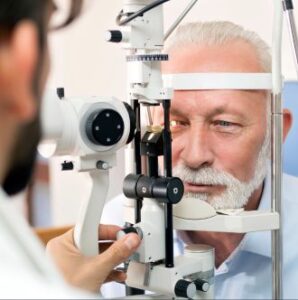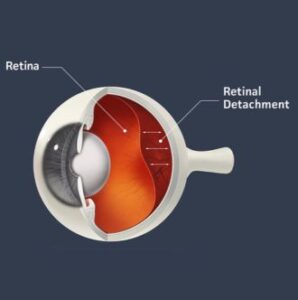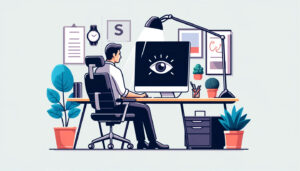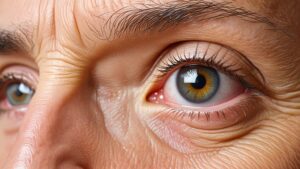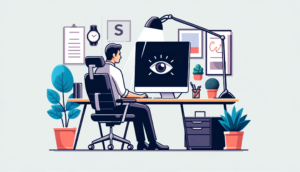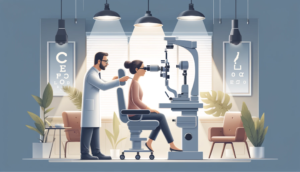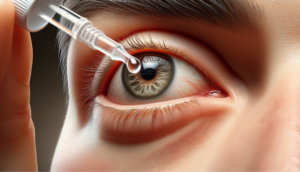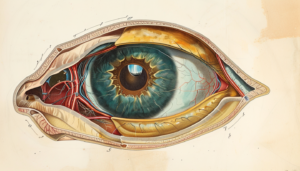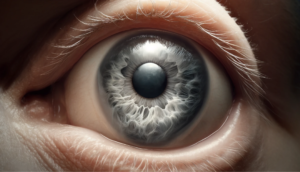Eye floaters, or simply ‘floaters’, are cobweb-like strands that appear to drift through or float through our vision. Some people also describe them as specks, spots, bugs, glass noodles or strings that seem to appear in the visual field (area of what we can see) and then seem to move away when you try to focus on them, and then slowly drift back. Floaters often appear more frequently in dim light or when looking at a plain background, such as a clear sky.
Floaters normally become more noticeable by age 50 and beyond, as the eye undergoes the normal aging process. Men and women seem to be equally affected with floaters. As we age, changes start to occur in the vitreous, the jelly-like substance that makes up approximately 80% of the inside of the eye, maintaining its shape.
The vitreous gel is composed of water (98%) and macromolecules, such as collagens and hyaluronan that hold the water in the vitreous. [3] Over time, the vitreous begins to shrink and liquify. As it does, it can cause the fibers of the posterior hyaloid face (a membrane that connects the vitreous to the retina) to separate from the retina, known as a posterior vitreous detachment (PVD), which is not usually visually threatening.
The changes in the vitreous can also cause some of the macromolecule fibers to clump together. These clumps of fibers are so fine that they can only be seen with a microscope, but they can cast shadows across the retina. The retina is composed of layers of light-sensitive cells at the back of the eye that transmit nerve impulses through the optic nerve to the brain, where a visual image is formed. We can’t actually see the clumps of fibers, but we see the shadows they cast as floaters. Over time, the vitreous begins to shrink and liquify.
Almost everyone experiences at least a few floaters from time to time. In most cases, floaters are completely harmless, although a little irritating. The majority of people are able to tolerate their floaters without any issue, while others may find them disruptive to their vision or ability to read or use a computer.
Although initially annoying, most floaters tend to eventually settle at the bottom of the eye, outside the area of vision. Floaters do not disappear or dissolve.
What causes eye floaters?
Although the most common cause of floaters is normal aging, they can appear for other reasons that may be related to other eye conditions. [4] The vitreous can undergo changes to its composition and structure resulting from trauma or injury, inflammation or an inflammatory disease, myopia (nearsightedness), disorders that cause changes to the vitreoretinal interface (the area where the vitreous contacts the retina) or changes in the eye due to diabetes. [2]
- Trauma or injury to the eye or recent eye surgery may also cause floaters to appear.
- Inflammation in the eye, such as in cases of posterior uveitis, can lead to inflammatory debris or cells that can cast shadows on the retina, appearing as floaters.
- Certain types of cancers, such as lymphoma, can increase the number of vitreous cells, causing some patients to notice an increase in floaters.
- Conditions such as diabetes or high blood pressure can cause tiny spots of blood (hemorrhages) to bleed into the vitreous and the microscopic blood cells can appear as specks or spot-like floaters. [1]
- Some eye surgeries or procedures that require injection of drugs or other material into the eye may cause floaters when small bubbles of air or drug cast shadows onto the retina. These floaters are usually temporary, and only remain until the injected substances can be absorbed by the eye, usually a few days.
Risk factors for eye floaters include:
- Over age 50
- Myopia (nearsightedness)
- Diabetes
- Hypertension (high blood pressure)
- Recent eye trauma or surgery
- Inflammatory disease
- Receiving intraocular injection treatment (injection of drug into the eye, usually for age-related macular degeneration or diabetic macular edema)
What is a Weiss Ring?
A Weiss ring is a type of floater that results from a PVD that occurs around the optic nerve head. It is a notably larger floater, usually in a circular, or semi-circular shape. A Weiss ring is usually harmless and usually disappears out of the visual field on its own. In a small number of cases, the PVD can cause a retinal tear, so it is important to seek medical attention if the appearance of the Weiss ring is accompanied by flashes of light or a curtain-type shadow effect.
Should I be worried about eye floaters?
Most often, floaters are not a cause for concern and do not threaten vision.
A sudden increase in the amount of floaters in your visual field may be a warning sign of other conditions, usually related to the retina, that may require immediate attention from an ophthalmologist. If there are floaters accompanied by other symptoms, such as worsening vision or the appearance of flashes of light (photopsia) or a curtain or shadow coming across the visual field, then an urgent examination by an ophthalmologist should be performed.
An ophthalmologist will conduct a thorough eye examination, carefully inspecting the vitreous and retina and ask several questions to try to get a complete history of symptoms. They will want to know how long you have been seeing floaters, when they increased, if you have had any recent injuries, trauma or eye surgeries and if you have any family members that have had a retinal detachment.
The ophthalmologist will likely use drops to dilate the pupil so that they can view the inside of the eye, the vitreous and surface of the retina to check for PVD or if there are any areas of retinal detachment or traction (pulling on the retina that may lead to a tear or detachment).
How common are eye floaters?
It is expected that almost everyone will experience at least a few floaters from time to time. A recent electronic survey asked people to self-report their experience with floaters. [6] Of the 603 respondents, and 76% reported seeing floaters, and 33% reported vision impairment because of their floaters. Interestingly, in this survey, people with refractive errors of myopia (nearsightedness) and hyperopia (farsightedness) were 3.5 and 4.5 times more likely to experience floaters, as compared to individuals without any refractive error (require corrective lenses to see clearly).
How are eye floaters treated?
For floaters that occur as part of the normal aging process, treatment is usually not recommended. The risk of removing a floater surgically poses a greater risk to vision than the floater itself. Some people find that simply moving their eyes up and down or side to side can shift the floater out of the visual field.
Floaters can be caused by a retinal tear or detachment, inflammation in the eye, or a hemorrhage from diabetes.
If the floaters are caused by another eye disorder such as a retinal tear or detachment, then that will be treated appropriately. If the floater is caused by inflammation in the eye or a hemorrhage from diabetes, then those underlying conditions will be treated, although the floaters may or may not resolve.
Although some floaters are not caused by a serious retinal problem that requires treatment, some people that have them feel that they are still disruptive to performing normal activities. Some ophthalmologists have recommended that their patients have their floaters treated with a laser (YAG vitreolysis), but this approach is not common. The special laser targets the problematic floaters and breaks them up to reduce the size of the shadows they cast, making them less noticeable. There are risks of laser therapy, such as damage to the retina caused by inadvertent laser contact.
Vitreoretinal surgeons can remove the vitreous in a vitrectomy procedure. Very small instruments are used to make a tiny incision in the eye and the vitreous is removed, along with the floaters, and replaced with another material (usually saline solution or gas bubble if there is a retinal tear) so that the eye can keep its shape. As with any eye surgery, there are risks to consider and may include infection, hemorrhage, retinal tears or cataract development.
Do eye floaters affect quality of life?
Floaters are often described as a mild annoyance, however research has found that floaters cam impact a person’s quality of life.
Most people describe their floaters as mildly annoying, however researchers have studied how floaters can impact a person’s quality of life. Recent studies have reported that floaters can have a significantly negative impact on an individual’s quality of life. [5, 7] They found that younger patients (<55 years of age) felt that the negative effect of floaters was so severe that they are more willing to accept a 7% risk of blindness to undergo a procedure to eliminate them. [5]
References:
[1] Coupland SE. The pathologist’s perspective on vitreous opacities. Eye. 2008;22(10):1318e29 https://www.ncbi.nlm.nih.gov/pubmed/18344965
[2] Gale J, Ikuno Y. Myopic vitreopathy, in Sebag J (ed) Vitreous – in Health and Disease. New York, Springer-Verlag; 2014.
[3] Milston R, Madigan MC, Sebag J. Vitreous floaters: Etiology, diagnostics, and management. Surv Ophthalmol. 2016 Mar-Apr;61(2):211-27. https://www.ncbi.nlm.nih.gov/pubmed/26679984
[4] Tozer K, Johnson M, Sebag J. Vitreous aging and Posterior Vitreous Detachment, in Sebag J (ed) Vitreous in Health and Disease. New York, Springer-Verlag; 2014. https://www.aaojournal.org/article/S0161-6420(18)31225-9/fulltext
[5] Wagle AM, Lim WY, Yap TP, Neelam K, Au Eong KG. Utility values associated with vitreous floaters. Am J Ophthalmol. 2011;152(1):60e5.e1 https://www.ncbi.nlm.nih.gov/pubmed/21570045
[6] Webb BF, Webb JR, Schroeder MC, North CS. Prevalence of vitreous floaters in a community sample of smartphone users. Int J Ophthalmol. 2013;6(3):402e5 https://www.ncbi.nlm.nih.gov/pubmed/23826541
[7] Zou H, Liu H, Xu X, Zhang X. The impact of persistent visually disabling vitreous floaters on health status utility values. Qual Life Res. 2013;22(6):1507e14. https://www.ncbi.nlm.nih.gov/pubmed/23054488

